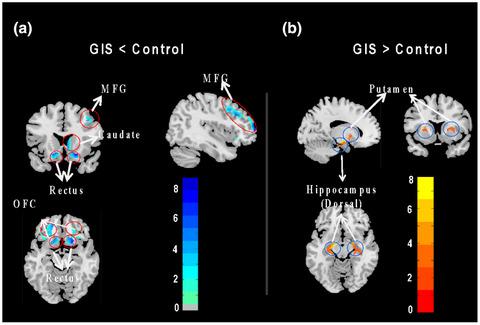当前位置:
X-MOL 学术
›
Int. J. Dev. Neurosci.
›
论文详情
Our official English website, www.x-mol.net, welcomes your
feedback! (Note: you will need to create a separate account there.)
The effects of gastrointestinal symptoms on structural gray matter volume in youth
International Journal of Developmental Neuroscience ( IF 1.7 ) Pub Date : 2020-06-23 , DOI: 10.1002/jdn.10044 Atiqa F Pirwani 1 , Zhuo Fang 2, 3 , Bo Li 4, 5 , Andra Smith 3 , Georg Northoff 2, 6 , Nafissa Ismail 1, 2
International Journal of Developmental Neuroscience ( IF 1.7 ) Pub Date : 2020-06-23 , DOI: 10.1002/jdn.10044 Atiqa F Pirwani 1 , Zhuo Fang 2, 3 , Bo Li 4, 5 , Andra Smith 3 , Georg Northoff 2, 6 , Nafissa Ismail 1, 2
Affiliation

|
Previous neuroimaging studies have examined the association between changes in brain structure and gastrointestinal symptoms (GIS), seen in disorders such as Irritable Bowel Syndrome and Irritable Bowel Disease. Studies in adults have found changes in white and grey matter volume (GMV) in patients with various gastrointestinal disorders. However, it is unclear whether GIS‐related structural changes in the brain are limited to adults or could be present throughout the lifespan. Given that gastrointestinal disorders are typically diagnosed between 4 and 18 years old, we investigated GIS‐induced morphological changes in pre‐adolescents (8–10), adolescents (12–16 years) and young adults (17–21 years). Using a voxel‐based morphometry (VBM) analysis, we compared regional grey matter volume (GMV) between participants with GIS and controls, using structural brain images from the Philadelphia Neurodevelopmental Cohort (PNC) database. A total of 211 participants (107 participants with GISs and 104 control participants) who had undergone structural magnetic resonance imaging were analysed. VBM analysis was used to objectively analyse GMV across the whole brain and compare between participants with GIS and controls. Participants experiencing GIS showed smaller GMV in regions within the limbic system/basal ganglia (bilateral caudate, bilateral ventral hippocampus, bilateral amygdala and bilateral superior orbital frontal cortex), and larger GMV in regions within the pain‐matrix (thalamus, bilateral putamen, right mid‐frontal gyrus) compared to controls. These differences were most prominent in the adolescent and young adult groups compared to pre‐adolescents. In conclusion, the structural differences found in participants with GIS support the need for further research into the neurophysiological impact of these symptoms.
中文翻译:

胃肠道症状对青少年结构性灰质体积的影响
之前的神经影像学研究已经检查了大脑结构变化与胃肠道症状 (GIS) 之间的关联,这些症状见于肠易激综合征和肠易激综合征等疾病。对成人的研究发现,患有各种胃肠道疾病的患者的白质和灰质体积 (GMV) 会发生变化。然而,目前尚不清楚大脑中与 GIS 相关的结构变化是否仅限于成人或可能存在于整个生命周期。鉴于胃肠道疾病通常在 4 至 18 岁之间被诊断出来,我们调查了 GIS 诱导的青春期前(8-10 岁)、青少年(12-16 岁)和青年(17-21 岁)的形态学变化。使用基于体素的形态测量 (VBM) 分析,我们比较了 GIS 参与者和对照组之间的区域灰质体积 (GMV),使用来自费城神经发育队列 (PNC) 数据库的结构大脑图像。共分析了 211 名接受过结构磁共振成像的参与者(107 名 GIS 参与者和 104 名对照参与者)。VBM 分析用于客观地分析整个大脑的 GMV,并在具有 GIS 的参与者和对照组之间进行比较。经历 GIS 的参与者在边缘系统/基底神经节(双侧尾状核、双侧腹侧海马、双侧杏仁核和双侧眶上额叶皮层)区域内的 GMV 较小,而在疼痛矩阵内区域(丘脑、双侧壳核、右侧)的 GMV 较大额中回)与对照组相比。与青春期前的儿童相比,这些差异在青少年和青年组中最为突出。综上所述,
更新日期:2020-06-23
中文翻译:

胃肠道症状对青少年结构性灰质体积的影响
之前的神经影像学研究已经检查了大脑结构变化与胃肠道症状 (GIS) 之间的关联,这些症状见于肠易激综合征和肠易激综合征等疾病。对成人的研究发现,患有各种胃肠道疾病的患者的白质和灰质体积 (GMV) 会发生变化。然而,目前尚不清楚大脑中与 GIS 相关的结构变化是否仅限于成人或可能存在于整个生命周期。鉴于胃肠道疾病通常在 4 至 18 岁之间被诊断出来,我们调查了 GIS 诱导的青春期前(8-10 岁)、青少年(12-16 岁)和青年(17-21 岁)的形态学变化。使用基于体素的形态测量 (VBM) 分析,我们比较了 GIS 参与者和对照组之间的区域灰质体积 (GMV),使用来自费城神经发育队列 (PNC) 数据库的结构大脑图像。共分析了 211 名接受过结构磁共振成像的参与者(107 名 GIS 参与者和 104 名对照参与者)。VBM 分析用于客观地分析整个大脑的 GMV,并在具有 GIS 的参与者和对照组之间进行比较。经历 GIS 的参与者在边缘系统/基底神经节(双侧尾状核、双侧腹侧海马、双侧杏仁核和双侧眶上额叶皮层)区域内的 GMV 较小,而在疼痛矩阵内区域(丘脑、双侧壳核、右侧)的 GMV 较大额中回)与对照组相比。与青春期前的儿童相比,这些差异在青少年和青年组中最为突出。综上所述,











































 京公网安备 11010802027423号
京公网安备 11010802027423号